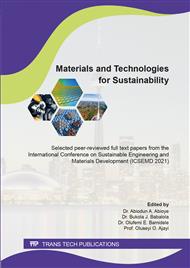[1]
Y. Liu, S. Tsukamoto, T. Shirane, and F. Abe, Formation mechanism of type IV failure in high Cr ferritic heat-resistant steel-welded joint, Metall. Mater. Trans. A Phys. Metall. Mater. Sci. 44, 10 (2013).
DOI: 10.1007/s11661-013-1801-0
Google Scholar
[2]
J.A. Francis, W. Mazur, and H.K.D.H. Bhadeshia, Review Type IV cracking in ferritic power plant steels, Mater. Sci. Technol. 22, 12 (2006) 1387–1395.
DOI: 10.1179/174328406x148778
Google Scholar
[3]
M. Ohgami, H. Naoi, S. Kinbara, H. Mimura, T. Ikemoto, and T. Fujita, Development of 9CrW tube, pipe and forging for ultra supercritical power plant boilers, Nippon Steel Technical Report. 72 (1997) 59–64.
Google Scholar
[4]
N.G. Peng, B. Ahmad, M.R. Muhamad, and M. Ahadlin, Microstructure Characterization for P92 Steels Subjected to Short Term Overheating above Critical Transformation Temperatures, Appl. Mech. Mater. 625 (2014) 114–117.
DOI: 10.4028/www.scientific.net/amm.625.114
Google Scholar
[5]
V. Sklenička, K. Kuchařová, M. Svobodová, M. Kvapilová, P. Král, and L. Horváth, Creep properties in similar weld joint of a thick-walled P92 steel pipe, Mater. Charact. 119 (2014), 1–12.
DOI: 10.1016/j.matchar.2016.06.033
Google Scholar
[6]
L. Milović, T. Vuherer, I. Blačić, M. Vrhovac, and M. Stanković, Microstructures and mechanical properties of creep resistant steel for application at elevated temperatures, Mater. Des. 46 (2013) 660–667.
DOI: 10.1016/j.matdes.2012.10.057
Google Scholar
[7]
P.J. Ennis and A. Czyrska-Filemonowicz, Recent advances in creep-resistant steels for power plant applications, Sadhana. 28(2003) 709–730.
DOI: 10.1007/bf02706455
Google Scholar
[8]
Y. Liu, S. Tsukamoto, K. Sawada, and F. Abe, Role of boundary strengthening on prevention of type IV failure in high Cr ferritic heat-resistant steels Metall. Mater. Trans. A Phys. Metall. Mater. Sci. 45,3 (2014) 1306–1314.
DOI: 10.1007/s11661-013-2072-5
Google Scholar
[9]
P. Parameswaran and K. Laha, Role of microstructure on creep rupture behaviour of similar and dissimilar joints of modified 9Cr-1Mo steel. Procedia Eng. 55(2013) 438–442.
DOI: 10.1016/j.proeng.2013.03.277
Google Scholar
[10]
L. Zhao et al., Investigation on mechanism of type IV cracking in P92 steel at 650 °C, J. Mater. Res. 26, 7 (2011) 934–943.
DOI: 10.1557/jmr.2011.11
Google Scholar
[11]
S. Bae, Fatigue and Oxidation Property of P92 Steel according to the Microstructure, p.399–400, (2010).
Google Scholar
[12]
D.R. Barbadikar, T. Sakthivel, A.R. Ballal, D.R. Peshwe, P. Syamala Rao, and M.D. Mathew, An assessment of mechanical properties of P92 steel weld joint and simulated heat affected zones by ball indentation technique, Mater. High Temp. 35, 5(2018) 427–437.
DOI: 10.1080/09603409.2017.1371913
Google Scholar
[13]
Y.Q. Peng, T.C. Chen, T.J. Chung, S.L. Jeng, R.T. Huang, and L.W. Tsay, Creep rupture of the simulated HAZ of T92 steel compared to that of a T91 steel, Materials (Basel). 10, 2, (2017).
DOI: 10.3390/ma10020139
Google Scholar
[14]
M. Dunđer, T. Vuherer, I. Samardžić, and D. Marić, Analysis of heat-affected zone microstructures of steel P92 after welding and after post-weld heat treatment, Int. J. Adv. Manuf. Technol. (2019).
DOI: 10.1007/s00170-019-03513-8
Google Scholar
[15]
ASTM, Standard Test Method for Microindentation Hardness of Materials,, ASTM Des. E384-05a, 14(2002), p.1–24.
Google Scholar
[16]
ASTM, Standard Test Methods for Notched Bar Impact Testing of Metallic Materials, ASTM Int. Des. E23-12c. I (2013). 1–25.
Google Scholar
[17]
C. Pandey, M. Mohan Mahapatra, P. Kumar, J. G. Thakre, and N. Saini, Role of evolving microstructure on the mechanical behaviour of P92 steel welded joint in as-welded and post weld heat treated state, J. Mater. Process. Technol. 263(2018) 241–255.
DOI: 10.1016/j.jmatprotec.2018.08.032
Google Scholar
[18]
C. Pandey et al., A brief study on δ-ferrite evolution in dissimilar P91 and P92 steel weld joint and their effect on mechanical properties, Arch. Civ. Mech. Eng. 18, 3(2018) 713–722.
DOI: 10.1016/j.acme.2017.12.002
Google Scholar
[19]
H.C. Dey, S.K. Albert, A.K. Bhaduri, G.G. Roy, R. Balakrishnan, and S. Panneerselvi, Effect of post-weld heat treatment (PWHT) time and multiple PWHT on mechanical properties of multi-pass TIG weld joints of modified 9Cr-1Mo steel, Weld. World, 58, 3 (2014) 389–395.
DOI: 10.1007/s40194-014-0124-0
Google Scholar
[20]
C. Pandey, A. Giri, and M.M. Mahapatra, Evolution of phases in P91 steel in various heat treatment conditions and their effect on microstructure stability and mechanical properties, Mater. Sci. Eng. A. 664 (2016) 58–74.
DOI: 10.1016/j.msea.2016.03.132
Google Scholar
[21]
C. Pandey, M.M. Mahapatra, P. Kumar, and N. Saini, Homogenization of P91 weldments using varying normalizing and tempering treatment, Mater. Sci. Eng. A. 710 (2017) 86–101.
DOI: 10.1016/j.msea.2017.10.086
Google Scholar
[22]
B. Arivazhagan and M. Vasudevan, A comparative study on the effect of GTAW processes on the microstructure and mechanical properties of P91 steel weld joints, J. Manuf. Process. 16, 2(2014), 305–311.
DOI: 10.1016/j.jmapro.2014.01.003
Google Scholar
[23]
C. Pandey, N. Saini, M.M. Mahapatra, and P. Kumar, Study of the fracture surface morphology of impact and tensile tested cast and forged (C&F) Grade 91 steel at room temperature for different heat treatment regimes, Eng. Fail. Anal., 71 (2017) 131–147.
DOI: 10.1016/j.engfailanal.2016.06.012
Google Scholar


